Hockey drills
- V1 passes the ball to V2.
- V2 takes on open/closed and finishes at goal.
- V1 passes the ball to A1.
- A1 attacks, V2 defends.
- V1 passes the ball to A2.
- A2 coincides with A1, V2 defends.
- V1 passes the ball to A3.
- A3 attacks together with A1 and A2, V1 and V2 defends.
- Points of attention:
- Let the defenders choose who they go for, on the ball or continue to cover their man.
- Attackers must keep moving.
- The exercise can be played on two sides.

- Player 1 passes the ball in the forehand to player 2.
- Player 2 takes the ball open/closed and passes it to player 3.
- Player 3 takes the ball open/closed and passes it to player 4.
- Player 4 takes the ball open/closed and passes it to player 5.
- Player 5 takes the ball open/closed and passes the ball to player 6.
- Player 6 takes the ball open/closed and runs to the back line along the blue pilons and passes the ball to player 7.
- Player 7 finishes off on goal.
- Fewer players?
- Remove a few pilons.
- Points of attention:
- Pay attention to posture while assuming
- Tight passes in the forehand
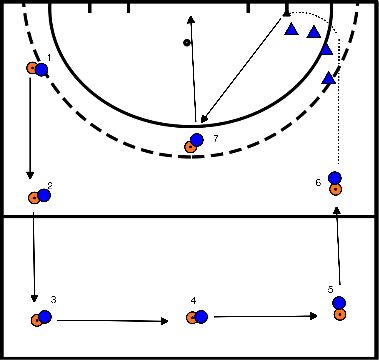
- Player 1 passes the ball to player 2.
- Player 2 takes the ball open/closed and runs to the blue pilon and rotates around it.
- Player 2 passes the ball to player 3.
- Player 3 takes the ball open/closed and runs to the blue pilon and turns around it.
- Player 3 passes the ball to player 4.
- Player 4 takes the ball open/closed and goes to the blue pilon and spins around it to the next blue pilon.
- Player 4 makes a feint (between the blue and white pilons) and passes the ball to player 5.
- Player 5 finishes on goal.
- If you have a closed control, place a pilon around which the player has to turn.
- Points of attention:
- Pay attention to the posture at the assumption
- Keep speed in the exercise
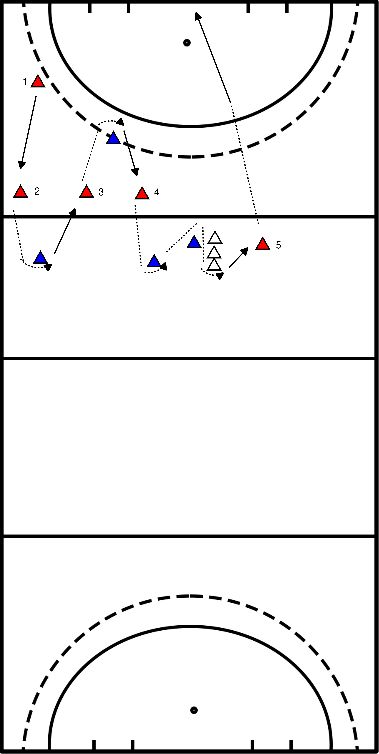
- Right: closed control
- Player at pilon 1 passes the ball to player at pilon 2.
- Player with pilon 2 takes the ball closed to the left of the pilon and then passes the ball to the player with pilon 3.
- Player on pilon 3 passes the ball to the player on pilon 2.
- Player on pilon 2 takes the ball closed around the pilon to his/her left and passes it to the player on pilon 1.
- Left: open control
- Player at pilon 1 passes the ball to player at pilon 2.
- Player on pilon 2 takes the ball open and passes it to the player on pilon 3.
- Player on pilon 3 passes the ball to the player on pilon 2.
- Player on pilon 2 takes the ball open and passes it to the player on pilon 1.
- Swap:
- The player chases the ball.
- Pay attention:
- You need a minimum of 5 players per exercise.
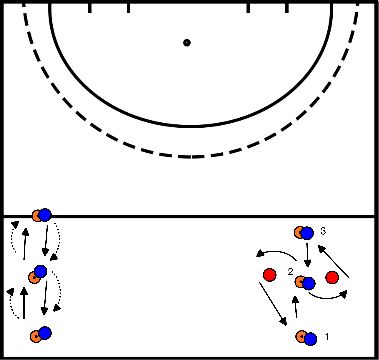
- Player 1 passes the ball to player 2, player 1 walks halfway to the red pilon of player 2.
- Player 2 passes the ball back to player 1.
- Player 2 moves on to the blue pilon, player 1 passes the ball to player 2.
- Player 2 passes the ball to player 3 on the red pilon, player 2 walks halfway to the red pilon of player 3.
- Player 3 passes the ball back to player 2.
- Player 3 passes the ball to the blue pilon, player 2 passes the ball to the passed player 3.
- Continue until player 7 can finish on goal.
- Points of attention:
- Tight passing
- Always keep looking at the ball
- Good attitude for open assumption
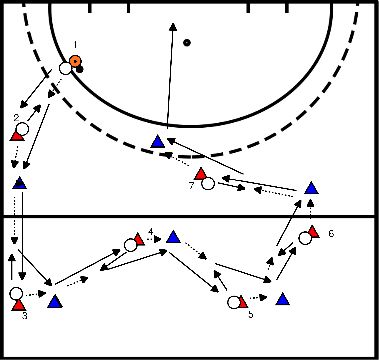
- Player 1 passes the ball to player 2.
- Player 1 runs through to create a triangle between player 1,2 and 3.
- Player 2 passes the ball to player 1 who ran in, player 1 passes the ball to player 3.
- Player 2 runs through to create a triangle between player 2, 3 and 4
- Player 3 passes the ball to player 2, player 2 passes the ball to player 4.
- This is repeated until the ball reaches player 6, player 6 shoots on goal.
- Easier:
- Put the pilons further apart and possibly put flaps on the spot where the player has to run to when he/she has to run in
- More difficult:
- Move the pilons closer together.
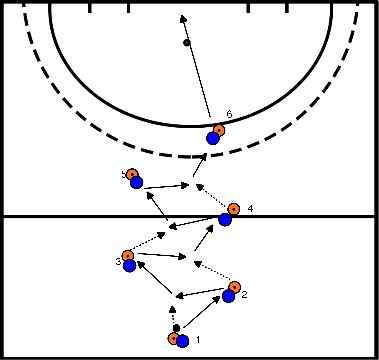
- There are 2 passers on the PC points on the back line to the right and left of the goal.
- The player starts behind the 25 yard line, receives the ball from the left, gets the ball to the semi-circle and then has to score.
- This player then sprints past the penalty mark, then sprints back behind the 25 yard line, and then has to run back towards the goal to receive the pass from the other attacker (right) and do the same (scoring, sprint past the strokepunt/puntball point and back to the 25 yard line)
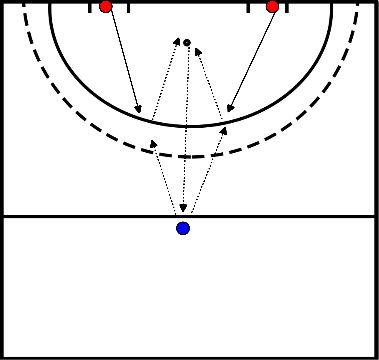
- Use pilons to set up two squares
- Around the dotted head circle (left and right next to/opposite the goal)
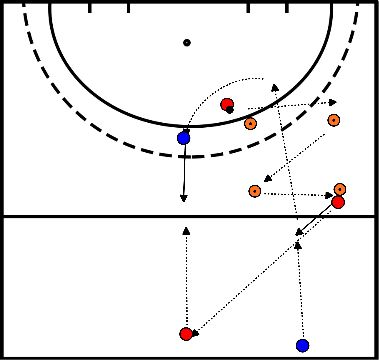
- Keeper on target
- Place 2 gates of pilons on the 23-metre line (the gates are on the left and right side of the goalposts)
- Player red starts on the head circle and accelerates with ball through the gates.
- Immediately after passing the gates, red passes to blue.
- Red sprints around a pilon to put pressure and/or take the ball away from blue.
- After receiving the ball, blue accelerates with ball and runs through the gates.
- If blue passes through the gates, red is not allowed to take the ball and has to go back to the pilon.
- Blue accelerates into the head circle and shoots at the goal.

- Make a triangle with pilons (2 meters between each pilon).
- Player red starts with ball at the pilon 5 meters away from the triangle.
- Player red passes to player blue while he dynamically moves towards and around the triangle.
- Player blue pivots the ball and plays the ball to player white.
- Player white plays the ball back to the starting point (red).
- During the exercise, each player runs behind his/her ball.
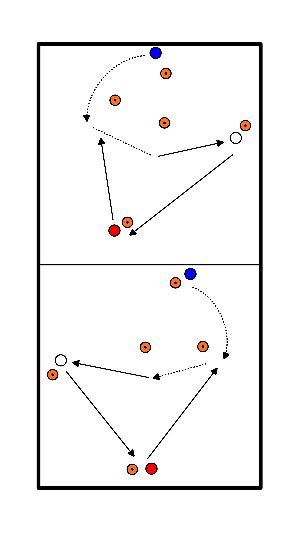
- The game starts with a pass from player 1 to player 2
- Player two gives a clean pass along the line
- Whereupon player 3 runs towards the line to receive the ball with a backhand
- Player 4 runs along the pilon and positions himself on the top of the circle or continues running by the tip.
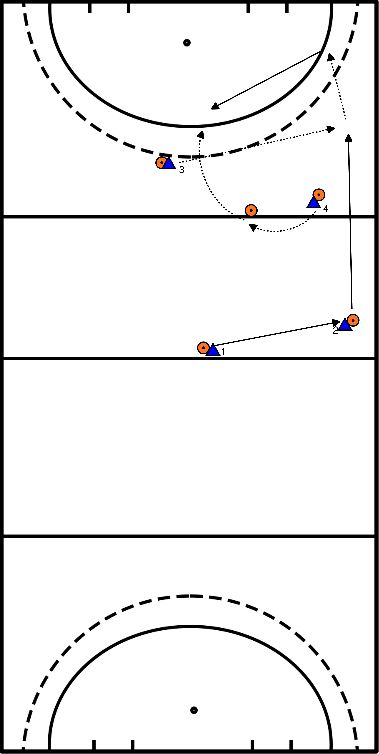
Place 15 to 20 pylons over a distance of about 40 metres from the rear line towards the middle line, in a straight line. The spacing between them at the basic form is 2 meters.
Make 2 rows that are positioned behind the back line. The players do their exercise on both sides of the pylons at the same time towards the end of the series of pylons. There they turn and dribble with a wide curve back to the beginning. When the first two are at the fourth pylon, the next two can start.
Put players with an equal physical capacity next to each other. You can do a positional approach (defender versus defender, attacker versus attacker).
Exercise
1. On the signal the front 2 players start.
2. Sprint each time 2 pylons forward and then 1 pylon backward.
3. Keep your face forward, so don't turn during the exercise.
4. The intensity is 90% of the maximum capacity. Especially the forward runs (starting away) must be explosive and with short steps.
5. At the end of the series of pylons you turn with a wide bend and dribble easily back to the starting point.
6. Repeat this exercise once.
Variations
1. Identical to the basic form, but now with the pylons in a different pattern: between the first 2 pylons is 1 meter, between the next 2 meters, then 3 meters, 4 meters and finally 5 meters. After this you go down again (respectively 4, 3, 2 and 1 meter space between the pylons). In total you will have 18 pylons.
2. Identical to the basic form, but now with a different pattern: between the first 3 pylons 1 meter, the next 2 pylons 5 meter, then again 3 pylons with 1 meter, 2 pylons with 5 meter. After this, place the same pattern again (4 times the same pattern in 1 line, with a total of 18 pylons).
3. Identical to variation 3, but now you don't place the pylons in a straight line, but in curves.
4. You make a straight line of pylons and arrange them as you see fit. Make sure there is a lot of variation.
5. Identical to variation 4, but now with faint curves.
Intensity of the exercise
The intensity is 90% of the maximum effort. Panting, should be motivated execution with highly explosive character in the runs with a maintained body control and athletic posture, EMI 7/8.








